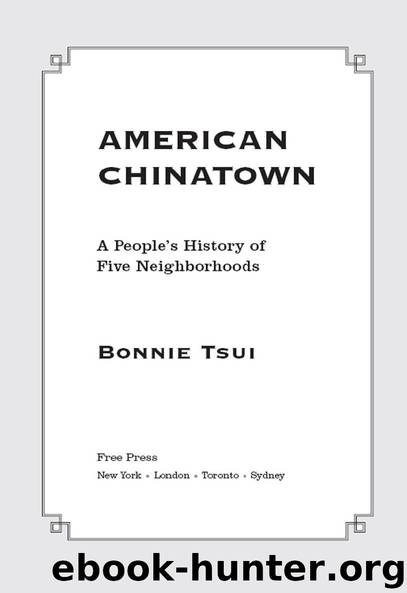American Chinatown by Bonnie Tsui

Author:Bonnie Tsui
Language: eng
Format: epub
Publisher: Simon and Schuster
Published: 2009-07-15T00:00:00+00:00
FOR ME, an outsider, a walk in Los Angeles’s Chinatown isn’t quite so personal. But still it has a compelling narrative: shared stories of vibrant worlds as told to me by ordinary people. It’s a pilgrimage through the neighborhood’s past to its present, all of its old parts linked up today by the modern connective tissue of concrete minimalls and the heavy car traffic filtering through its four-and six-lane streets. Chinatown itself has a bit of the L.A. urban sprawl. At the southern end is Old Chinatown’s Garnier Building, considered at the turn of the twentieth century as the Chinese City Hall. One afternoon, I headed north from there, passing Union Station, the reason for Old Chinatown’s demise, and strolling through the vast parking lot that was once China City. By the time I got to the Central and West Plazas, on the northern edge of the neighborhood near the entrance to the 110 Freeway, I’d encountered plenty of the bi-level shopping centers and marketplaces—Bamboo Plaza, Dynasty Center, Far East Plaza—that filled in around New Chinatown in the decades following the momentous arrival of Central Plaza.
In this jumble of eras, I saw the children of Chinatown, and how their lives intersected with neighborhood history. In the Chinese American Museum, schoolkids were invited to peruse exhibits that described the Chinese Massacre of 1871, in which the accidental shooting of a white man led a mob of five hundred Angelenos to attack Chinatown, killing nineteen Chinese men and boys. On weekends, packs of teenagers roamed the streets, sucking down bubble teas and sifting through cheap trinkets in outdoor shop bins. In Central Plaza’s main pedestrian square, I sat in the shade of a bearded palm tree and watched young martial-arts troupes in blazing-orange garb prepare to perform for tourists, while elementary-school kids rode their bikes in circles and flung gunpowder snaps—gleefully, if somewhat viciously—at passersby. One block over, I walked behind a young couple strolling hand-in-hand into Phoenix Bakery, a kitschy, powder-blue landmark that has been advertising “Chinatown Famous Birthday Cakes” for seventy years. Not everyone wonders about the formative events that shape the place where they live, but the lure of lore has always been an insistently powerful part of Chinatown’s draw.
Annie, for one, has found ways to link up to those stories. When I first met her, she was working at the front desk of the city’s Chinese Historical Society of Southern California, which is housed in a blue-and-red-painted Victorian house on the north side of Chinatown. On a bright spring afternoon, I stood outside on the front porch with Eugene Moy, a program director for the society and a wonderful raconteur. A mass of unruly rosemary bushes lining the porch railing was fragrant in the sunshine. Moy recalled that his parents ran one of the many Chinese mom-and-pop grocery stores in the city during the 1940s. To him, Chinatown was the place the family came for weddings and banquets, where he visited his grandparents. “Here I am fifty years later, still here,” he mused, as we watched teenagers across the street walking home from school.
Download
This site does not store any files on its server. We only index and link to content provided by other sites. Please contact the content providers to delete copyright contents if any and email us, we'll remove relevant links or contents immediately.
| African-American Studies | Asian American Studies |
| Disabled | Ethnic Studies |
| Hispanic American Studies | LGBT |
| Minority Studies | Native American Studies |
Cecilia; Or, Memoirs of an Heiress — Volume 1 by Fanny Burney(32058)
Cecilia; Or, Memoirs of an Heiress — Volume 3 by Fanny Burney(31455)
Cecilia; Or, Memoirs of an Heiress — Volume 2 by Fanny Burney(31405)
The Great Music City by Andrea Baker(30780)
We're Going to Need More Wine by Gabrielle Union(18629)
All the Missing Girls by Megan Miranda(14717)
Pimp by Iceberg Slim(13777)
Bombshells: Glamour Girls of a Lifetime by Sullivan Steve(13683)
Fifty Shades Freed by E L James(12909)
Talking to Strangers by Malcolm Gladwell(12866)
Norse Mythology by Gaiman Neil(12821)
For the Love of Europe by Rick Steves(11447)
Crazy Rich Asians by Kevin Kwan(8886)
Mindhunter: Inside the FBI's Elite Serial Crime Unit by John E. Douglas & Mark Olshaker(8699)
The Lost Art of Listening by Michael P. Nichols(7158)
Enlightenment Now: The Case for Reason, Science, Humanism, and Progress by Steven Pinker(6870)
The Four Agreements by Don Miguel Ruiz(6312)
Bad Blood by John Carreyrou(6274)
Weapons of Math Destruction by Cathy O'Neil(5827)
